Special Collections Auction 141 - 213
Lots 001 - 213
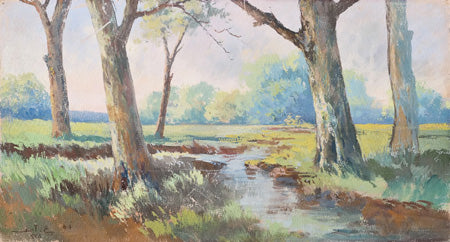
OSMAN ASAF LANDSCAPE
Lot 141
Signed in Old Turkish, dated h.1338 (1919). Mixed technique on paper.
Size: 27.5 x 50 cm.
Price: 5,000 TL / $337,838.00
CATALOGUE NOTES
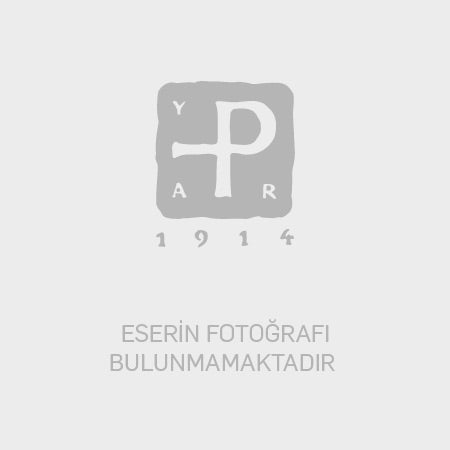
RUSSIAN SILVER TEA SET
Lot 141-A
CATALOGUE NOTES
St. Petersburg. Between 1908 - 1917. Consisting of a teapot, teapot, sugar bowl and milk jug. A swollen body with a handle and lid on 4 legs in the form of a branch. The lid handle is in the form of a pine cone. The mouth and lid are surrounded by water formed by stylized curled leaves in engraving technique. Stamped 84 (875 carat)...
Dimensions: Weight: 1.092 g.
Price: 1,500 TL / $101,351.00

FRENCH BACCARAT BOWL AND PLATE
Lot 142
Size: Height: 28cm.
Price: 5,000 TL / $337,838.00
Diameter: 38 cm.
CATALOGUE NOTES
The bowl has a flat bottom, a bulbous body and a domed lid. The plate has a flat bottom and low rim. It is segmented. The rim of the bowl, the handle of the lid and the segmented border of the plate are surrounded by gilded water. 19th - 20th century.

CANTON PORCELAIN BOWL - PLATE AND A PAIR OF VASE
Lot 143
20th century.
Size: a. Height: 14 cm. b. Height: 30 cm.
Price: 4,000 TL / $27,027.00
CATALOGUE NOTES
a. The bowl has a flat bottom and a swollen body. The plate has a flat bottom and a wide body. It is decorated with floral motifs and local figures in various colors appropriate to the style on a white background.
b. Vases have flat bottoms, swollen bodies, narrow necks and wide mouths. The neck is surrounded by a stylized branch motif in relief. It is decorated with flower motifs and local figures in various colors appropriate to the style on a white background.
Diameter: w. 33 cm.
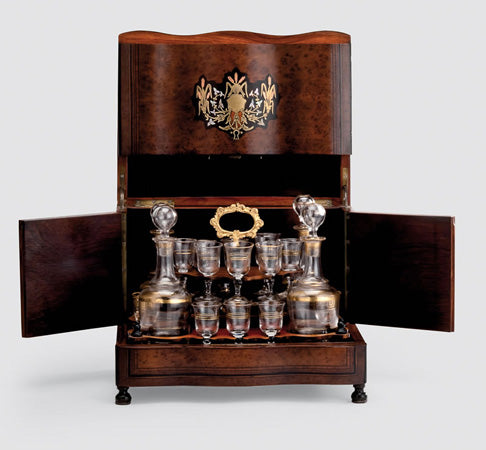
CRYSTAL LIQUOR SET
Lot 144
Price: 4,000 TL / $27,027.00
CATALOGUE NOTES
It consists of 2 liqueurs and 16 various glasses. It is decorated with gilded geometric patterns on a colorless background. There is a medallion consisting of gilded branch and flower motifs on the lid of its wooden case. 2 glasses are broken. 19th - 20th century.

SIX PORCELAIN COFFEE CUPS AND PLATES
Lot 145
Aquamarine with stylized gold leaf on a white background. With 6 filigree silver spoons. 19th - 20th century.
Price: 250 TL / $168,919.00
CATALOGUE NOTES
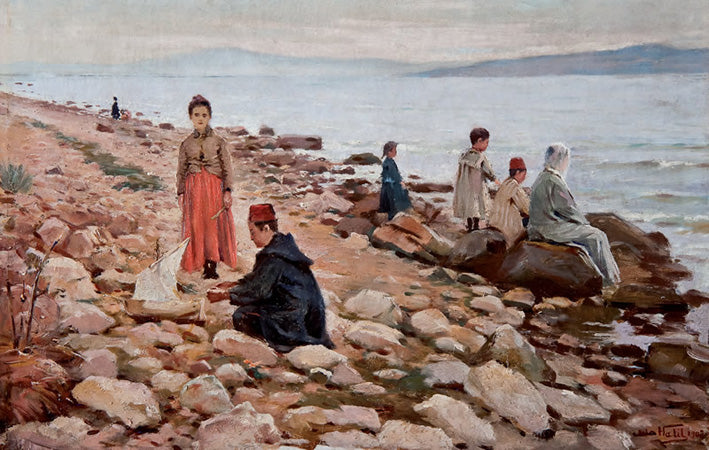
HALIL PASA FAMILY ON BOSTANCI BEACH
Lot 145-A
Signed in Old Turkish and Latin letters, dated 1902. The signature and date of the painting have been enhanced by the artist. Oil on canvas. Restored.
Size: 40 x 60 cm.
Price: 250,000 TL / $168,919.00
CATALOGUE NOTES
A masterpiece by Halil Pasha, who brings together the academic tradition of the Gerome and Courtois workshops where he was educated and the love of light and color of Impressionist painting with the unique atmosphere and local beauties of Istanbul.
Halil Pasha, who often uses his own family members as models in the geography of Istanbul that he walks step by step, seems to be giving a lesson in both perspective and how to apply paint to the canvas surface with this painting. The spot figures placed in decreasing sizes from front to back along the shore and the stones placed in the composition not as inanimate objects but as living, breathing elements add an extraordinary liveliness and dynamism to the entire painting. With a toy sailboat in his hand and a little girl right next to it, facing us, the artist points to a different moment of daily life in the late Ottoman period.
The artist, who painted in many of his paintings in neighborhoods such as Çengelköy, Arnavutköy, Bostancı, and Pendik, where the light licks the surfaces with different effects at different times of the day, must have painted this composition in one of these coastal areas. Halil Paşa, who dedicated his endless search for light and color to the city he lives in, presents every subject he deals with to the service of the art of painting with a rich, plural narrative.
HALIL PASHA
He graduated from the School of Engineering with the rank of lieutenant. He was also assigned to the “adjutant” class and assigned to the palace. He went to Paris in 1880. He worked in the GeÅLrôme and Courois workshops. When he returned to the country in 1888, he received the ranks of major, district governor and colonel. He taught art at the School of Medicine for two years. He became the assistant director of the museum in 1905. He taught art at the War School until 1908. He was appointed director of the Academy in 1917-1918.
During this period, he implemented a new work program. He gave private lessons to students interested in art. One of the first female painters, Müfide Kadri, was also a student of Halil Pasha. Later, he was in Egypt as a guest of Abbas Hilmi Pasha. He painted landscapes from this region.
The classical methods he had been using until then were gradually replaced by an impressionist palette. Halil Pasha's visits to Egypt, the dates of which cannot be determined with certainty, show a period in which the artist also held exhibitions in this country and was perhaps more respected than in Turkey. In the landscapes he painted here, he transferred the dead brightness of Egyptian nature to his canvases.
Halil Pasha, who had a habit of putting dates on his paintings, has paintings as his most valuable documents showing where he was and when. The influences of post-impressionism and the Barbizon school can be seen in the landscapes of the artist, who is a representative of the transition between the 19th and 20th centuries. He is one of our painters who uses light and shadow most skillfully. The figures in his paintings have the artist's unique style and anatomical features.
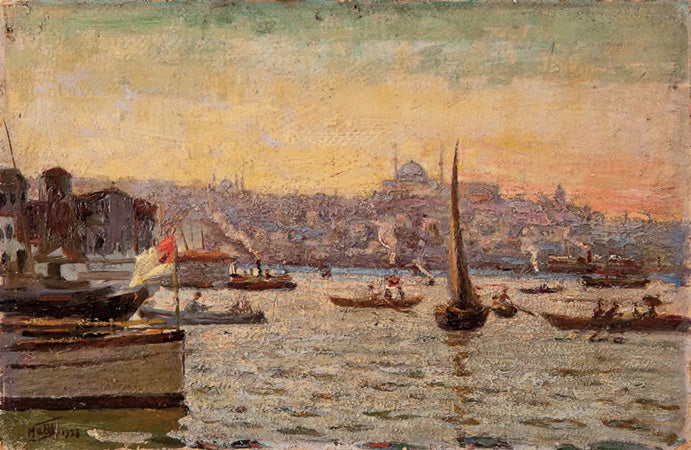
HALIL PASA HORN
Lot 146
Signed, dated 1925. Oil on cardboard.
Size: 29 x 45 cm.
Price: 100,000 TL / $675,676.00
CATALOGUE NOTES
Dr. SA Collection.
Halil Pasha, who graduated from the Military Junior High School and the Harbiye and worked as an art teacher for a short time at the Harbiye, was sent to Paris by his father and studied at the GeÅLrôme and Courtois workshops. It is known that Halil Pasha, who participated in the Paris Universal Exhibition in 1889 and 1900, won an award with his painting "Madam X" at the 1900 exhibition. The artist, who was appointed as the assistant director of the Imperial Museum upon his return from Paris, became a teacher at the School of Fine Arts in 1917.
Halil Pasha went to Egypt as a guest of the Khedive of Egypt, Halim Pasha, after the Second Constitutional Era. During his trips around the Nile River, he studied the changes in shadow and light, just like the Impressionist painters, and returned to Istanbul with many landscape paintings that showed impressionist tendencies.
Halil Pasha continued his impressionist tendencies, which he had started in Egypt, when he returned to Istanbul. He made paintings in districts such as Çengelköy, Arnavutköy, Bostancı and Pendik, where the light reflected with different effects at different times of the day. For this reason, Halil Pasha, who is also known as the "Bosphorus Painter", continued his impressionist tendencies in 1914.
It is also closely related to the inclusion of the 1914 Generation or Calli Generation, who returned from Paris with an impressionist palette. This small "jewel" landscape, which illuminates the historical peninsula, the Golden Horn, and sailboats under a scorching summer sun, is a very special painting that shows the level the artist was able to reach with an impressionist color palette.
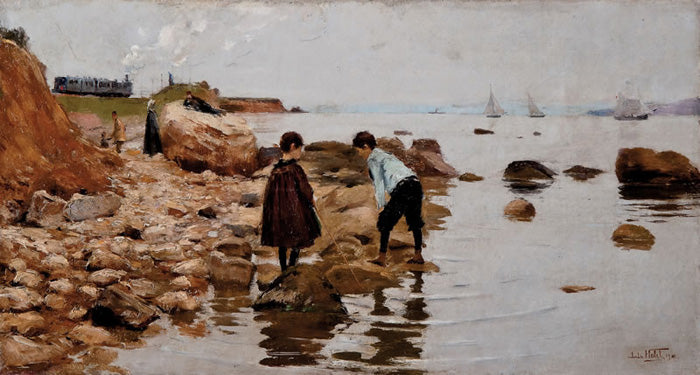
CHILDREN PLAYING ON THE BEACH OF HALIL PASA BOSTANCI
Lot 147
Signed in Old Turkish and Latin letters, dated 1902. Oil on canvas. Rentualized.
Size: 33 x 61cm.
Price: 175,000 TL / $118,243.00
CATALOGUE NOTES
Halil Pasha, who was in Paris between 1880 and 1888, is the only important painter of ours who lived in a period when academic art and impressionism both clashed and intersected. The artist, who brought the pattern from an academic understanding, the color enthusiasm from impressionism and painting outdoors to his paintings, masterfully connects both of his knowledge in this work. He not only makes the rocks licked by the sea on the shore and the small waves hitting the shore visible with an optical illusion, but also proves that he has a masterful understanding of figures with the two children who form the center of the painting. The steam train moving from the left of the composition to the depths must be a reference to the modernization in the paintings of Turner, who is considered the father of English Romanticism. The sailboats and the silhouette of Istanbul that appear in a hazy atmosphere in the depths of the painting are also a kind of respect for this city that the artist treats with great appetite in every painting.
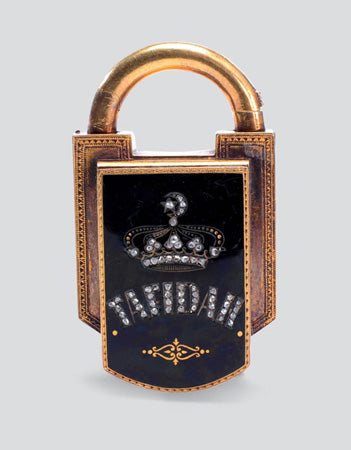
SWISS ENAMEL AND DIAMOND GOLD WATCH
Lot 147-A
CATALOGUE NOTES
Dial with Roman numerals. Cylinder escapement. Lock-shaped gold body processed with black solid enamel technique. The keyhole on the front cover and the "Khedive Coat of Arms" and "TAŞDAN" inscriptions on the back cover are adorned with diamonds. With gold key. End of 19th century - beginning of 20th century. 18 carat.
Price: 15,000 TL / $101,351.00
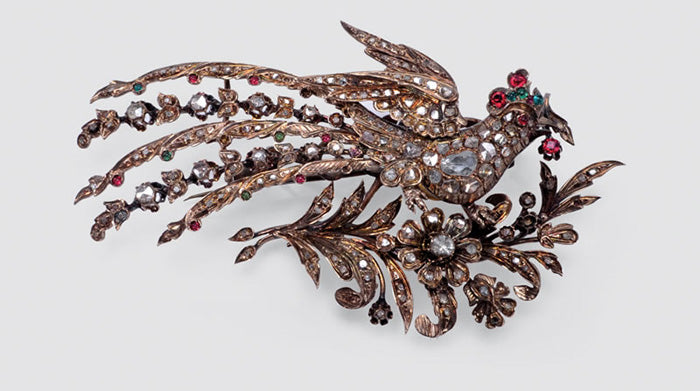
OTTOMAN DIAMOND BROOCH
Lot 147-B
Gold mount in the form of a peacock. Embellished with diamonds. Spring mechanism. 19th century. Diamonds approximately 4 carats. Gold 18 carats.
CATALOGUE NOTES
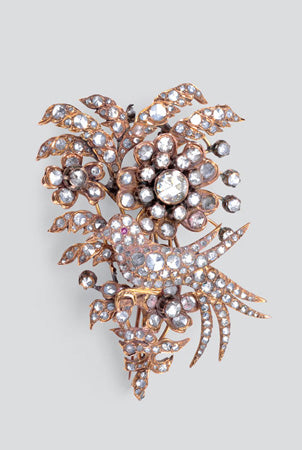
OTTOMAN DIAMOND BROOCH
Lot 147-C
CATALOGUE NOTES
Gold setting in the form of a large leafy branch and bird. Embellished with diamonds. Spring mechanism. 19th century. Diamonds approximately 10 carats. Gold 18 carats.
Price: 35,000 TL / $236,486.00
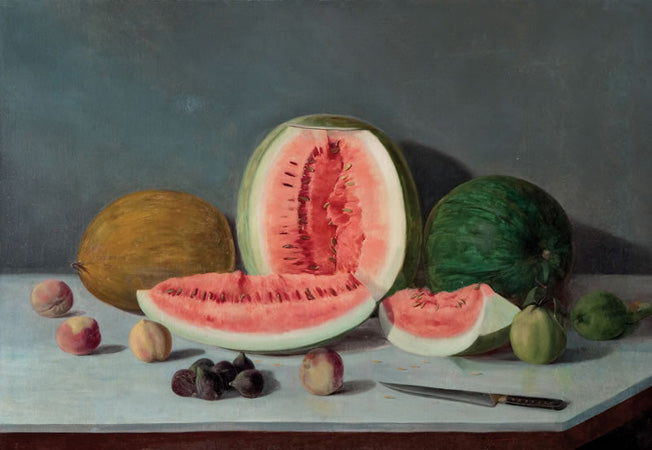
STILL LIFE WITH SÜLEYMAN SEYYIDKARPUZLU
Lot 148
Signed in Old Turkish, dated 1323 (1905). Oil on canvas. Rentualized.
Size: 81.5 x 116.5 cm.
Price: 900,000 TL / $633,803.00
CATALOGUE NOTES
STILL LIFE WITH WATERMELON
Among thematic selections of Turkish painting, still life painting takes the first place. Despite the changes brought by periods, forms and innovation, and the searches attempted to be realized on the path to modernity, an unchanging reality The connections established with still life painting. Undoubtedly, landscape paintings have priority, but still lifes are determined in the second place. The pioneer of the painters who chose still life paintings is 'Süleyman Seyyid Efendi'. Other artist friends such as Süleyman Seyyid Efendi, who are among the first generation artists of Ottoman painting in the Constitutional Era, will also make still life paintings.
SULEYMAN SEYYID
He completed his primary and secondary education at Maltepe and Maçka military secondary schools. He attracted the attention of his teachers Chirans and Kees with his charcoal and watercolor paintings on history during his studies at İdadi and Harbiye. He was sent to Mekteb-i Osmaniye in Paris by Sultan Abdülaziz. He developed his artistic knowledge with the education he received there on “menazır”, “resm-i hati”, “resm-i talidi” and “resm-i mücessen”. When Mekteb-i Osmani was closed, he worked for a while with Cabnel, one of the famous teachers of that period. He graduated from Paris School of Fine Arts. He returned to Istanbul in 1875. He worked as an assistant to the painter Osman Nuri Pasha for a while. Later, he became an art teacher at Harbiye. He continued his teaching at Kuleli Military High School and Military Medical School. He contributed to the establishment of “Mülkiye-i Şahane”. Süleyman Seyyid mostly chose still lifes, especially oranges, as subjects in his paintings. Süleyman Seyyid, who was nicknamed “metrologiste” because he paid great attention to the rules of perspective, wrote a book called “Fenn-i Meazır” which he could not publish. Süleyman Seyyid, as an early impressionist in Turkish paintings, influenced the generations that came after him and succeeded in overcoming the strict formalism of the classical painting tradition.
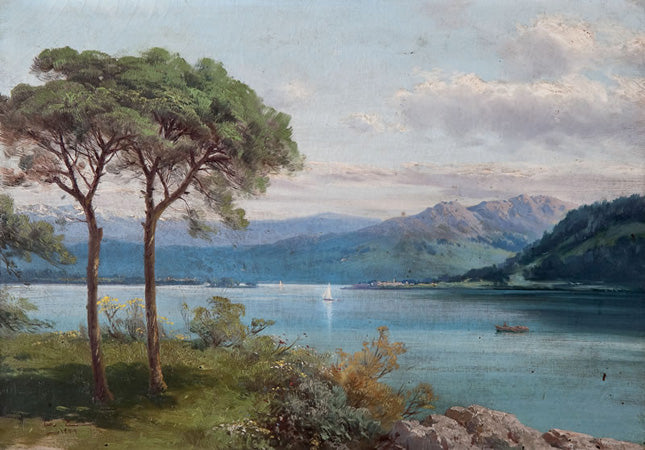
HOCA ALI RIZA SAPANCA
Lot 149
Signed in Old Turkish, dated May h.1326 (1908). Oil on canvas. Has very minor flaws.
Size: 46 x 65 cm.
Price: 400,000 TL / $270,270.00
CATALOGUE NOTES
An extraordinarily elegant slice of nature that Hoca Ali Rıza transformed into his classic signature by transferring all his virtuosity. On the left of the painting, stone pine trees that also emphasize a perspective order, a mountain range swallowed by the sky on the horizon, small hills disappearing into each other and a sea bathed in light...
With these typical compositions that have now become his clear signature, Hoca Ali Rıza deserves all the praise as one of the pinnacles of the relationship between nature and landscape in Turkish painting.
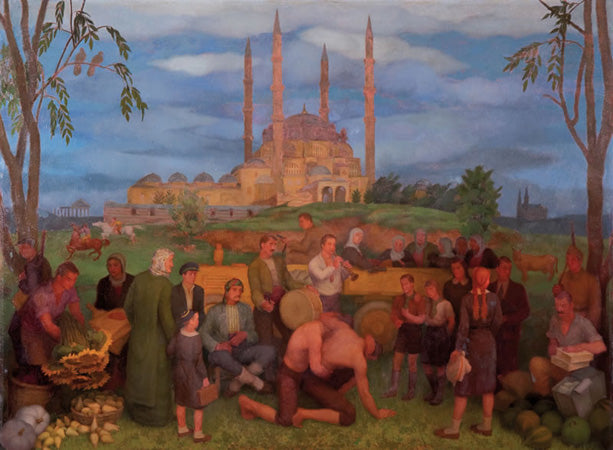
MAHMUT CUDA IN FRONT OF SELIMİYE MOSQUE KIRKPINAR
Lot 150
Unsigned. On the business card of Mahmut Cuda attached to the back it says "Edirne 122 x 91.5 cm. Mahmut Cuda painter Aynalicesme street 69-3 Beyoglu". Oil painting on cardboard.
Size: 91.5 x 122 cm.
Price: 450,000 TL / $304,054.00
CATALOGUE NOTES
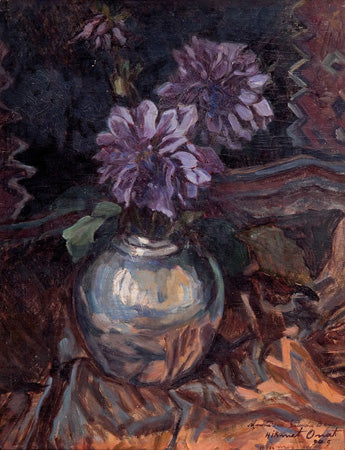
HİKMET ONAT PURPLE CHRYSEMOTIONS
Lot 151
CATALOGUE NOTES
Signed, dated 1945 and dedicated to "Respected Sueda Bey". The painting bears the artist's two signatures in Latin letters. Oil on plywood.
Size: 49 x 38 cm.
Price: 25,000 TL / $168,919.00
HIKMET ONAT
Born in Istanbul, Hikmet Onat graduated from the School of Fine Arts in 1910. He went to Paris the same year and worked in the studio of Fernand Cormon at the School of Fine Arts. He returned to his homeland in 1914 and participated in the traditional Galatasaray exhibitions. He taught there for a long time upon the suggestion of the Academy Director Halil Edhem.
He opened his first personal exhibition in Ankara in 1976. The artist, who was an open-air painter, frequently worked on the theme of the sea in his paintings. He skillfully transferred rowboats, barges and their reflections on the water to his canvases in the landscapes of Kandilli Ridge, Çengelköy Hills, Rumelihisarı, Sarıyer, Üsküdar and Bebek. He was one of the first Turkish painters, like Nazmi Ziya, to sincerely feel the effect of light on forms and colors, using the touch technique consisting of small vivid color values. The powerful light effects that created deep reflections on the transparent water surfaces of sea and river boats remained on the agenda in all stages of his art. His most important feature, which he could not give up in his panoramic views of Istanbul, his portraits, his figurative compositions and his canvases depicting architectural structures, was his strong understanding of perspective. He added colors to this narrative with the dynamic spottiness of free brush strokes. The spots would meet with enthusiastic and vivid colors in an unbroken integrity. Among the indispensable colors of bright and luminous appearances, white has a special place in his works.
Working as a nature painter was the main passion of Onat's artistic life. His works are in the Istanbul and Ankara State Painting and Sculpture Museums and private collections.
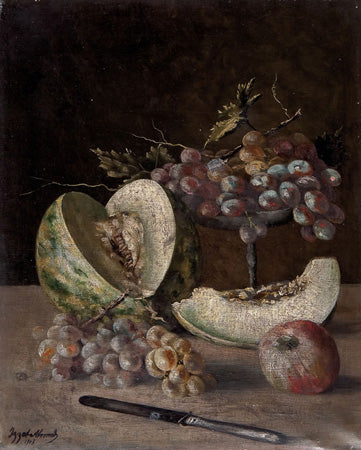
İZZED AHMED STILL LIFE WITH MELON AND GRAPE
Lot 152
CATALOGUE NOTES
Signed, dated 1903. Oil on canvas. Has 2 small holes.
Size: 43 x 36 cm.
Price: 55,000 TL / $371,622.00
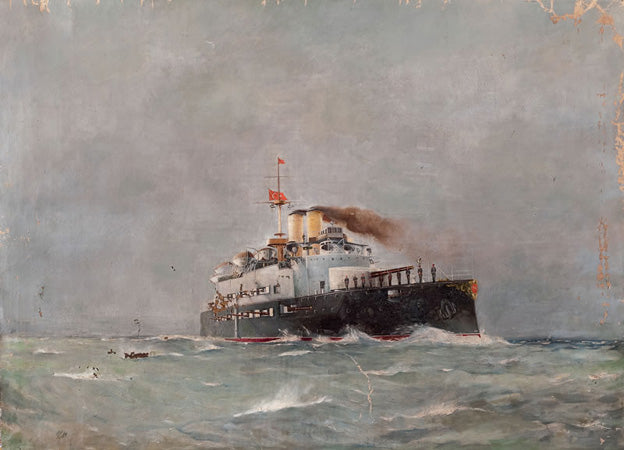
MUSTAFA MESUDİYE ARMOR
Lot 153
Signed in Old Turkish. Oil on canvas. Shabby.
Size: 72 x 100 cm.
Price: 18,000 TL / $121,622.00
CATALOGUE NOTES

MEHMED FEHMI HİLYE-İ ŞERİF
Lot 154
CATALOGUE NOTES
Ketebeli, dated 1315 (1897). Allah, Muhammad, Basmala, the names of the 4 Caliphs and the verses of the Prophet Muhammad are written in celi thuluth and thuluth script. The inner and outer borders are illuminated with two-coloured gold and various floral motifs in rococo style.
Size: 127 x 90 cm.
Price: 180,000 TL / $121,622.00
In the history of Ottoman calligraphy, the Naskh script was radically reformed several times. We know that Sheikh Hamdullah in the late fifteenth century and Hafiz Osman in the late seventeenth century almost re-established the Naskh script. In the nineteenth century, there was a crossroads in the Naskh script:
On one hand, the style of Kazasker Mustafa İzzet Efendi, and on the other hand, the style of Mehmet Şevki Efendi. Calligraphers such as Şefik Bey, Abdullah Zühdi Efendi, and Hasan Rıza Efendi wrote in the Kazasker valley and created masterpieces. However, some calligraphers today consider Şevki Efendi's mature age as the final stage of the Naskh script. Here, Mehmed Fehmi Efendi (1293 - 1333 / 1876 - 1915) was one of Şevki Efendi's most prominent students.
Since most of his works were destroyed when his house in Aksaray burned down, it is rare today; however, this hilye shines even among that rarity. Fehmi Efendi, one of the few calligraphers who wrote large-sized hilyes like Kazasker and Hasan Rıza, tried a different arrangement by writing the names of Ism-i Celâl and Ism-i Nebi on both sides of the absolute Basmala on the head office, and Hasaneyn on each side of the skirt. But it can be said that the most beautiful aspect of the work is its pearl-like Naskh script, which has lost none of its elegance despite its size.
Ottoman rococo illumination also adds a special richness to the work.
ICS
MEHMED FEHMI
He was born in Istanbul. He is the son of İbrahim Hilmi Efendi, one of the teachers at Valde School. He received his education at Valde School. He became a hafiz. He could recite the Quran very well. He was a student of the famous calligrapher Mehmet Şefik Bey. He was a member of the Quran proofreading committee.
Many of his works were burned down along with his house in the Great Fatih Fire. For this reason, his works are very rare.
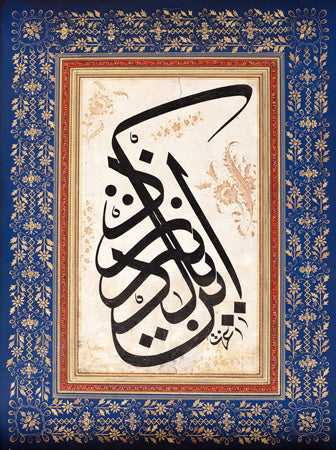
KAZASKER MUSTAFA IZZETLEVHA
Lot 155
CATALOGUE NOTES
KAZASKER MUSTAFA IZZED
He was born in Tosyalı. After the death of his father Destanağazade Mustafa Ağa, he went to Istanbul. He worked at the Başkurşunlu Madrasah in Fatih. He increased his knowledge in the Silahdar Gazi Ahmed Paşazade Ali Paşa Department for three years. In the meantime, he started learning writing. He played the ney for a long time and was interested in singing. He received his ijazah by learning thuluth and nesih from the Hamidiye Evkaf district governor Çömez Mustafa Vâsıf Efendi and talik from Yesarizade Mustafa İzzed.
With the accession of Sultan Abdulmecid to the throne, he was appointed as the preacher of the Eyüp Mosque and later became the second imam. He served as the judge of Thessaloniki, Mecca, and Istanbul at various dates and as the Anatolian Kazasker in 1849. He then became a writing instructor for the princes. He trained many valuable calligraphers. Mehmed Şefik, Muhsinzade Abdullah, Vahdeti, Abdullah Zühtü, Burdurlu Hâfız Osman, Mehmed Hilmi and İlmi were among his students.
Ketebeli, dated AH. "This too shall pass" written in Persian in celî sülüs script. Restored.
Size: 59 x 44 cm.
Price: 30,000 TL / $202,703.00
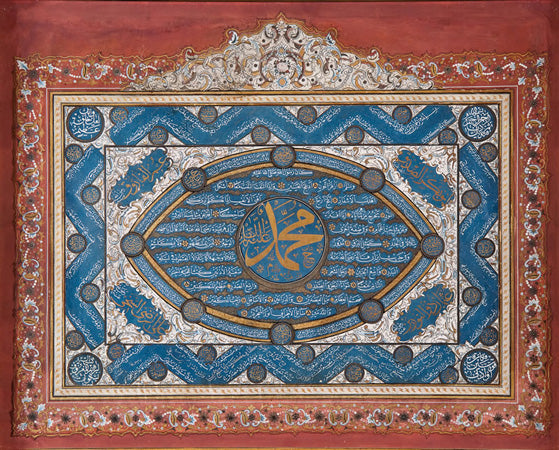
HAFIZ MEHMED SURURI HİLYE-I SHERİF
Lot 156
Size: 53 x 66 cm.
Price: 30,000 TL / $202,703.00
CATALOGUE NOTES
With ketebeli. The Basmala, the Vasisha of Hz. Muhammad, the names of the 4 caliphs and the Esmaünnebi are written in Thuluth and Naskh calligraphy using white ink on a blue background. Illuminated with gold in the Rococo style.
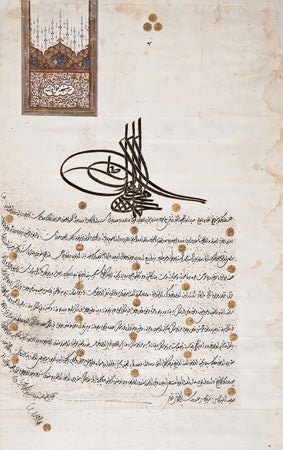
EDICT
Lot 157
CATALOGUE NOTES
Sultan Ahmed III (1703 - 1730) Tughra. Dated 1120 (1708). On the upper part, there is the phrase "Let it be done as it is necessary" written by the sultan's own hand. The Tughra is drawn in black ink. Written in Diyarbakır in broken divani script using black ink. From Zerefşan. "In the province of Şami Sharif, m...
Size: 63.5 x 40 cm.
Price: 12,000 TL / $810,811.00
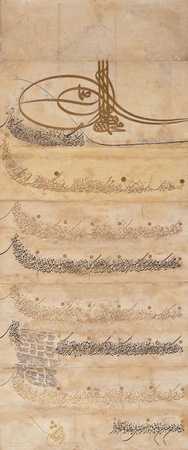
BERATED
Lot 158
CATALOGUE NOTES
Sultan IV. Mehmed (1648 - 1687) with the tughra. Dated 1059 (1649) . Its tughra is drawn in gold. Written in Istanbul with celi divani script using gold and black ink. “Ahmed, who was the owner of a zeamet of 6,000 akçe in Magre Sanjak and sub-district, and 60,000 akçe in Ahmed Karası Sanjak, is mentioned in the places...
Size: 93 x 38.5 cm.
Price: 18,000 TL / $121,622.00
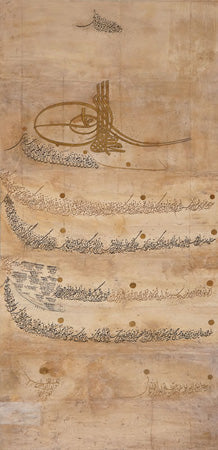
BERATED
Lot 159
CATALOGUE NOTES
Sultan Mehmed IV (1648 - 1687) with the signature. Dated 1069 AH (1658). The signature was drawn in gold. Written in Edirne in Divanî calligraphy using gold and black ink. With Zerefşan. “Mustafa, who was the owner of a zeamet of 30,256 silver coins from the Kariye called Asi and other places in the Şeman district of Aleppo Sanjak, 34,082...
Size: 80 x 38 cm.
Price: 15,000 TL / $101,351.00
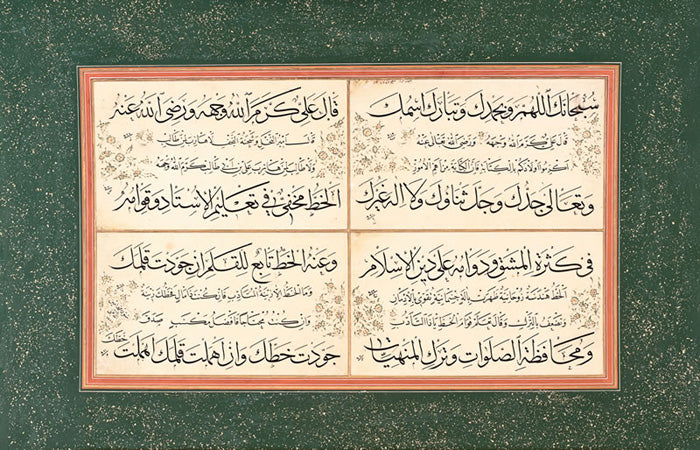
HASAN TAHSIN'S MIND HASAN TAHSIN'S MIND
Lot 160
Ketebeli, dated 1258 (1842). The Suphaneke Prayer and the words of Hz. Ali regarding calligraphy are written in thuluth and naskh script.
Size: 44 x 63 cm.
Price: 5,000 TL / $337,838.00
CATALOGUE NOTES
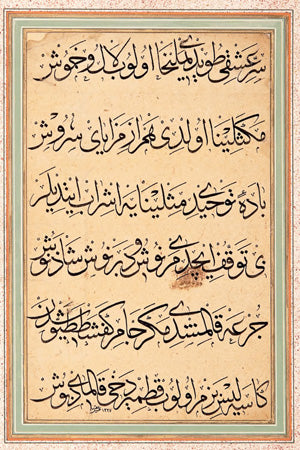
HASAN TAHSİN LEVELS
Lot 161
CATALOGUE NOTES
Ketebeli, dated 1327 (1909). Poems about the Seven Sleepers written in Thuluth calligraphy.
Size: 38.5 x 30 cm.
Price: 5,000 TL / $337,838.00
This poem about Ashab-ı Kehf (Seven Sleepers) was written in the thuluth script by many Ottoman calligraphers, especially Şefik Bey. Uğur Derman says the following about this subject: “It is not known who wrote this müsedde. However, some of the 19th century Ottoman-Turkish calligraphers tried to write the above poem in thuluth script - as if to test themselves. For example, it is known that Hafiz Tahsin Efendi (1267 - 1334 / 1851 - 1915) wrote this müsedde thousands of times. The reason for this is that the Turkish verses seen fit harmoniously on the line and in some places the letters are placed on top of each other and are combined.” The verse is as follows: “Yemlîhâ heard the secret of love and became red and raw / Mekselînâ became the companion of the grave / They bid farewell to the Mislînâ wine of unification / Mernûş and Debernûş, Şâzenûş drank without hesitation / It turned out that they had been left to Cur from the glass of Kefeştatayyûş / The bowl of beret became a rag and even Kıtmîr remained empty.” Here is one of the works of Hafız Hasan Tahsin Efendi in which he wrote this poem.
ICS
HASAN TAHSIN
He is from Tophane. After studying at the primary school, he became a hafiz. He learned Thuluth and Naskh from Şefik Bey and Talik from Sami Efendi. He also wrote for Rık. He worked as a writing instructor at Galatasaray Sultani and Darüşşafaka. He worked at Mahmud Bey Printing House for a while.

SHEIKH HAMDULLAH KIT'A
Lot 162
Without a colophon. On the back is the phrase "El Hac Şeyh Hamdullah el-Amasi's late, aliyyül âlâ calligraphy" by Hamid Aytaç. "May mercy be upon Ömer, son of Abdulaziz" and phrases related to fate, patience and destiny are written in thuluth and naskh calligraphy. The border is marbled.
Size: 15 x 22 cm.
Price: 5,000 TL / $337,838.00
CATALOGUE NOTES
SHEIKH HAMDULLAH
He was born in Amasya. His father Mustafa Dede migrated from Bukhara to Amasya. He was known as “Sheikh Efendi” because he was a member of the Suhrawardi order. He took lessons from Hayreddin Mar’ashi, who learned the six types of writing from Abdullah Sayrafi, a student of Yakut Musta’sımı. Sultan Bayezid II was a governor in Amasya before he ascended to the throne. He met Sheikh Hamdullah there. Sultan Bayezid II’s interest in writing also opened a new horizon in Hamdullah’s life. Sultan Bayezid II received writing lessons and an ijazah from Sheikh Hamdullah.
After Bayezid ascended to the throne, he invited Hamdullah to Istanbul. He gave him a practice room in the Harem-i Hümayun in Topkapı Palace. He was the sheikh of the Okmeydanı Archers' Lodge. The title "Sheikh" comes from there. The Sultan gave him seven tablets of Yakut's writings to examine. Hamdullah studied the writings on the tablets for forty days and forty nights, without leaving the room. Finally, Yakut gave such an air to his writing that everyone who saw it was amazed.
This admiration he gathered increased Hamdullah's enthusiasm. The Sultan's admiration for him caused the ulema group to be jealous of Hamdullah. When Yavuz Sultan Selim ascended to the throne, Hamdullah's star faded. During this period, the Sheikh began to withdraw to a small hut in Alemdağ and spend his days in prayer. When Kanuni ascended to the throne, he thought of showing him the respect he had not received from Yavuz and invited him to his presence.
He asked him to write the Holy Quran. The 47 Quran-writing Sheikhs wrote more than a thousand chapters as Enam, Evrad and Juz.
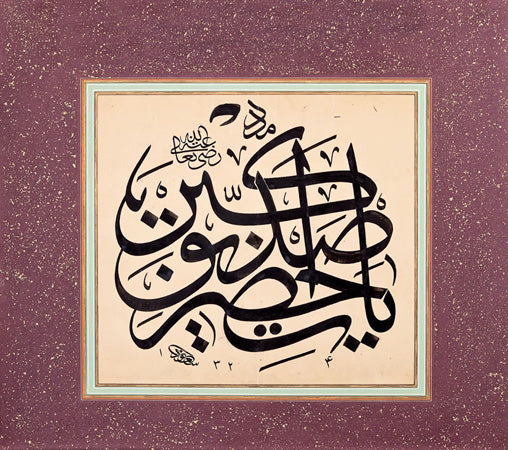
SUUD AL-MAWLAVI PLATE
Lot 163
Size: 39 x 41cm.
Price: 5,000 TL / $337,838.00
CATALOGUE NOTES
The ketebeli is dated 1324 (1906). It says “Medet Ya Hz. Sıddık-ı Ekber” in celi sülüs calligraphy.
Mehmed Su'ud Bey (1299 - 1367 / 1882 - 1948) was the grandson of the calligrapher Vahdeti Efendi, and a student of Beşiktaşlı Nuri, Muhsinzâde Abdullah, Kamil Efendi and Tuğrakeş İsmail Hakkı Bey. A copy of this celi sülüs stack with minor differences in the vowels, with the writing "Meded Ya Hazret-i Sıddık-ı Ekber (i.e. Hz. Ebûbekir) radiy Allahu teâlâ anhu", is in the Mahmud Kemal İnal collection of İbnülem and has been included in the book The Last Calligraphers (p. 379).
ICS
SAUDU'L MEVLEVI
He studied at Mekteb-i Hamidiye in Beşiktaş. He learned Arabic and Persian from his father. He entered the Imperial Divan's Office of Important Writing in 1899. He learned the Thuluth and Naskh script from his father and Nuri Korman.
Then he learned divan from Muhsinzade Abdullah, and celi divani and script from Kamil Akdik. He had a calligraphy certificate and a millise rank from the divan department.

“THE SEVEN TOWERS” SEYYID ABDULLAH LEVHA (MURAKKAH)
Lot 164
CATALOGUE NOTES
Ketebeli. Kaside-i Bürde written in thuluth and naskh calligraphy. Restored. 7 pages.
Size: 125 x 25cm.
Price: 25,000 TL / $168,919.00
“THE SEVEN TOWERS” SEYYID ABDULLAH
He was born in the Yedikule district of Istanbul. Since his lineage goes back to the Prophet Muhammad, he would mention his seyyid status in his signatures. His other name is Emir.
He started to practice Aklam-i Sitte with Hafiz Osman when he was 17 years old. He received his diploma in a short time of 40 months. He continued his duty as the imamate of Imrahor Mosque until the end of his life. He wrote Mushaf, En'am, numerous kı'a, murakka, Hilye and other books and educated many students. "Eğrikapılı" Mehmed Rasim Efendi and Şekerzâde Mehmet Efendi were his most famous students. He was appointed as the practice teacher of Topkapı Palace with the interest of Sultan Ahmed III.
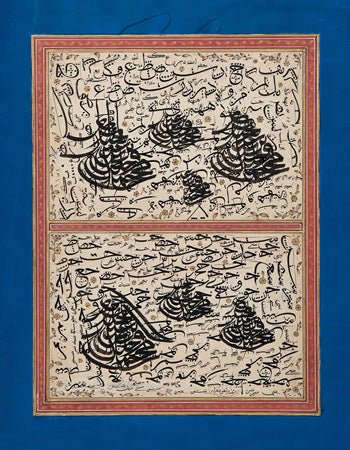
MURTAZA 2 TUĞRA scribble
Lot 165
CATALOGUE NOTES
Sultan VI. Mehmed Vahidded's signatures. Ketebeli.
Size: 40 x 32 cm.
Price: 10,000 TL / $675,676.00
MURTAZA
He received his primary and secondary education at home with private tutors. He entered the Sanay-i Nefise in 1903 and graduated in 1908. He learned the Talik script from his father and the Thuluth script from Ali Nihai Efendi. He first served in the registry of the Registered Ahual Commission in Bab-ı Ali, then in the Amedii Divanı-ı Hümayun. He served as a chamberlain clerk until the reign of Sultan Mehmed VI Vahideddin. He wrote a dictionary from Turkish to Persian, but it could not be published.
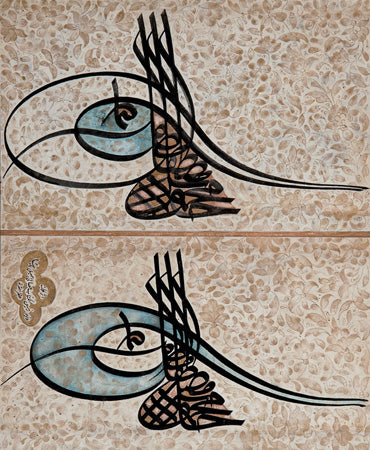
VIZER REİS'ÜL KÜTTAB HİSALI İSMAİL PAŞA2 TUĞRA PLATE
Lot 166
Sultan Mahmud I's Tughras. 18th century
Size: 50 x 42 cm.
Price: 15,000 TL / $101,351.00
CATALOGUE NOTES
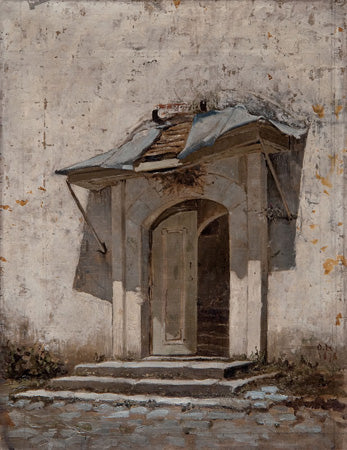
OSMAN HAMDI DESTROYED DOOR
Lot 167
Monogrammed, dated 1878. Oil on canvas.
Size: 35 x 27 cm.
Price: 280,000 TL / $189,189.00
CATALOGUE NOTES
– It is included in the book “Opening to the West in Art and Osman Hamdi”, p.663, published in Istanbul by Erol Kerim Aksoy Foundation Publications in 1995 and prepared by Mustafa Cezar. This picturesque painting, which the artist created with sensitive brush strokes of paint and depicts a ruined door, carries a monumental expression that is prevalent in his orientalist compositions, despite its small size. It is most likely a work made as a result of observation, not a photograph.
Prof. Dr. Semra Germaner
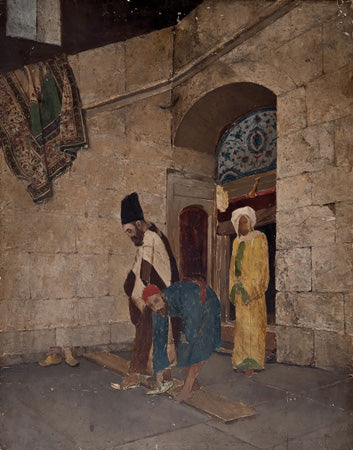
OSMAN HAMDI LEAVING THE MOSQUE
Lot 168
CATALOGUE NOTES
Unsigned. Oil on wood.
Size: 51 x 40.5 cm.
Price: 225,000 TL / $152,027.00
– It is included in the book “Opening to the West in Art and Osman Hamdi”, prepared by Mustafa Cezar and published in Istanbul by Erol Kerim Aksoy Foundation Publications in 1995, p.756.
It is one of Osman Hamdi Bey's unfinished paintings. The painting is important in terms of giving an idea about the artist's working method. The painting is developed in two stages. Osman Hamdi Bey first transfers the architectural forms that he enlarges by framing them from a photograph onto the canvas, then places figures performing various movements inside it. In this painting, although the architecture, the tiles on the door pediment and the carpet hanging from the wall to the left of the painting have been worked on, the figures are not completed. Painting from photographs is a method commonly used by 19th century Western painters.
In the painting depicting three people leaving the mosque in front of the east gate of the Rustem Pasha Mosque, the yellow-robed figure standing in the background is Osman Hamdi Bey himself. The artist depicted himself in the same place in two separate paintings titled “In Front of the Rustem Pasha Mosque”.
Prof. Dr. Semra Germaner
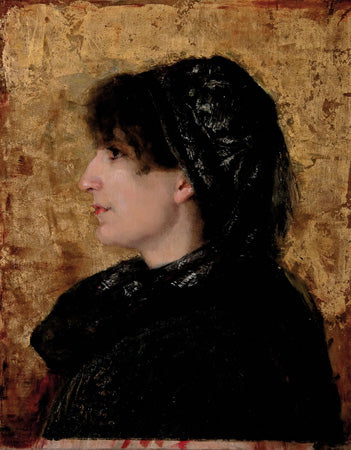
OSMAN HAMDI NAİLE HANIM PORTRAIT
Lot 169
CATALOGUE NOTES
(OSMAN HAMDI BEY'S WIFE) Unsigned. Oil on canvas. Rentualized.
Size: 52 x 41cm.
Price: 450,000 TL / $316,901.00
– It is included in the book “Opening to the West in Art and Osman Hamdi”, p.755, prepared by Mustafa Cezar and published by Erol Kerim Aksoy Foundation Publications in Istanbul in 1995.
This painting has a special place among Osman Hamdi Bey's portrait works with the use of gold gilding in the background. The gold gilding background behind the holy people in Byzantine icons emphasizes the value the artist gives to his wife and therefore to women. In addition, the dark blue clothing on the light-reflecting gold gilding also refers to icons.
The profile, drawn with a clear yet sensitive understanding of pattern, and the volumes provided by very soft shadows give the face a classical expression, while the hair, the coverlet and the clothing that complete the coiffure are realized as a dark stain with freer brush strokes. Giving priority to the face but painting the surroundings with freer brush strokes is a feature frequently encountered in the artist's portraits.
Prof. Dr. Semra Germaner
OSMAN HAMDI BEY'S WOMEN'S PORTRAITS
Among the works in the collection of Osman Kerman, the grandson of Osman Hamdi Bey's daughter Leyla, there are three oil painting portraits of women, two of whom belong to his wife Naile and one of whom belongs to his daughter Leyla.
In addition to his orientalist paintings, Osman Hamdi Bey also made many portraits. These portraits of his family and close circle of people provide information about the social position of the person whose portrait was painted.
In contrast to the static and linear compositions of Osman Hamdi Bey's orientalist paintings, his portraits are more painterly and have stronger ties to life. In fact, Osman Hamdi Bey also demonstrates great success in his self-portraits, which are included in his orientalist paintings and which we know he worked with from photographs.
These paintings reflect the characteristics of 19th century French portrait art. In this period when the psychological portrait genre gained prestige, pastel works were widely made as well as oil paintings. Miniature portraits were also common in the 19th century. In the late 19th century French portrait examples, the use of a naturalistic approach to the face of the person being painted while finishing the other parts with quick brush strokes as if they were a sketch, and sometimes painting the background halfway so that the canvas can be seen from underneath, is a type of expression that Osman Hamdi Bey also resorted to in his portraits from time to time.
Osman Hamdi was the first artist to address the theme of women in Turkish painting. The artist, who frequently included female figures in his orientalist paintings, also used his wife and daughters as models in his portraits.
It is also possible to observe the characteristics of Ottoman upper class women, such as their clothing and hairstyles, from these paintings.
Prof. Dr. Semra Germaner
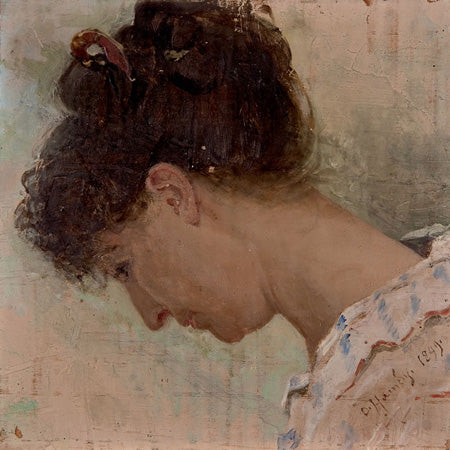
OSMAN HAMDI NAİLE HANIM PORTRAIT
Lot 170
Signed, dated 1899. Oil on wood.
Size: 17 x 17 cm.
Price: 110,000 TL / $743,243.00
CATALOGUE NOTES
– It is included in the book “Opening to the West in Art and Osman Hamdi” prepared by Mustafa Cezar and published by Türkiye İş Bankası Culture Publications in Istanbul in 1971, p.269.
– It is included in the book “Opening to the West in Art and Osman Hamdi”, prepared by Mustafa Cezar and published in Istanbul by Erol Kerim Aksoy Foundation Publications in 1995, p.708.
Osman Hamdi Bey made portraits of his wife Naile Hanım in different periods. The most well-known of these is the large-scale Woman with Mimosas dated 1906. This portrait has a special place among other paintings with its diagonal composition, dominance of light tones, fresh, luminous, free paint application. The portrait is like the determination of a special moment of life. As can be seen in Woman with Mimosas after the 1890s, Osman Hamdi Bey began to use dynamic axes in his paintings. Perhaps these new experiments of his may have been influenced by the impressionist painting that had become official in Paris in those years.
Prof. Dr. Semra Germaner
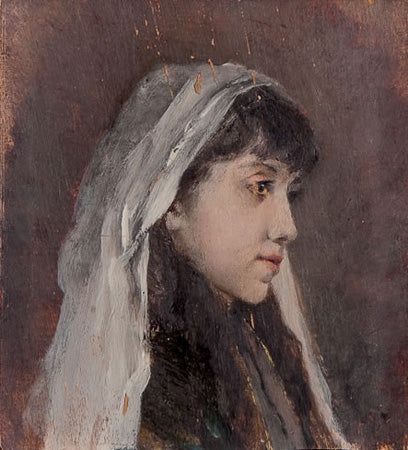
OSMAN HAMDI HANIM LEYLA PORTRAIT
Lot 171
(OSMAN HAMDI BEY'S DAUGHTER) Unsigned. The back of the wood is written "Mars, Leyla 1891". Oil painting on wood.
Size: 9.5 x 8.5 cm.
Price: 70,000 TL / $472,973.00
CATALOGUE NOTES
– It is included in the book “Opening to the West in Art and Osman Hamdi”, prepared by Mustafa Cezar and published by Türkiye İş Bankası Culture Publications in Istanbul in 1971, p.221.
– It is included in the book “Opening to the West in Art and Osman Hamdi”, prepared by Mustafa Cezar and published in Istanbul by Erol Kerim Aksoy Foundation Publications in 1995, p.694.
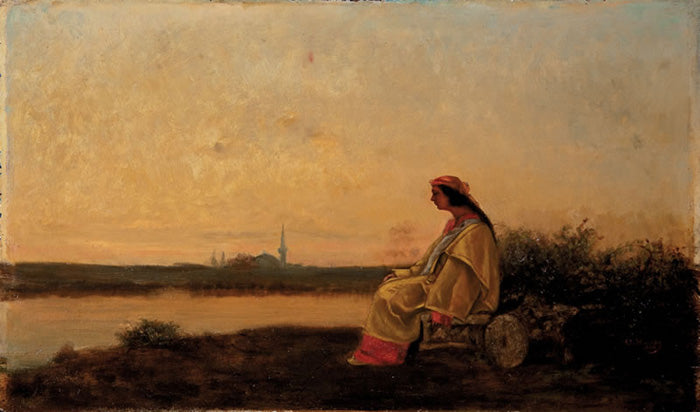
OSMAN HAMDI LONGING FOR ISTANBUL
Lot 172
Signed, dated 1866. Oil on wood. Restored.
Size: 34 x 57 cm.
Price: 400,000 TL / $270,270.00
CATALOGUE NOTES
– It is included in the book “Opening to the West in Art and Osman Hamdi”, prepared by Mustafa Cezar and published in Istanbul by Erol Kerim Aksoy Foundation Publications in 1995, p.656.
It is one of the earliest paintings made by Osman Hamdi Bey during his student years in Paris, when he was far from Istanbul. Therefore, it has a documentary feature in terms of showing how he started his art career. The main feature of the painting is its sincerity. The figure in the foreground would be the main element of his paintings in the future. In this work of the artist, unlike his later orientalist compositions, the figure is associated with nature, not architecture. The horizontality of the composition and the dim light used add a calmness but also sadness to the painting in accordance with its subject.
Prof. Dr. Semra Germaner

OSMAN HAMDI PORTRAIT
Lot 173
CATALOGUE NOTES
Monogrammed. There is a note in the lower left corner stating who the portrait belongs to. Pencil drawing on paper.
Size: 15 x 8.5 cm.
Price: 10,000 TL / $675,676.00
Osman Hamdi Bey's Charcoal Drawings Osman Hamdi Bey has many portrait drawings that he made in Iraq in 1869 and in Bulgaria in 1876. (See Mustafa Cezar, Opening to the West in Art and Osman Hamdi, 1995, pp.763 - 771) These drawings, which can be explained by the artist's interest in ethnography, are examples drawn from live models.
Prof. Dr. Semra Germaner
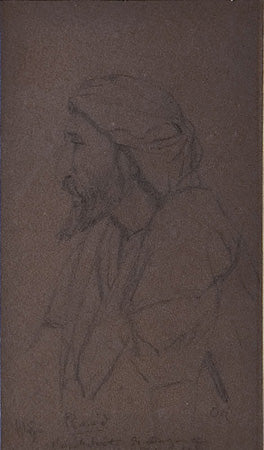
OSMAN HAMDI PORTRAIT
Lot 174
CATALOGUE NOTES
Monogrammed. There is a note in the lower left corner stating who the portrait belongs to. Pencil drawing on paper.
Size: 15 x 8.5 cm.
Price: 10,000 TL / $675,676.00
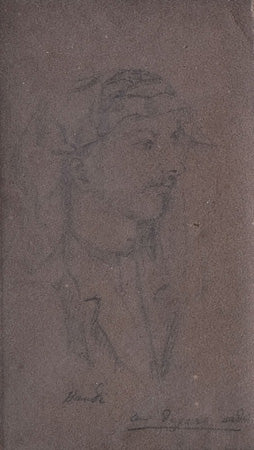
OSMAN HAMDI PORTRAIT
Lot 175
CATALOGUE NOTES
Signed. There is a note in the lower right corner stating who owns the portrait. Pencil drawing on paper.
Size: 15 x 8.5 cm.
Price: 10,000 TL / $675,676.00

OSMAN HAMDI PORTRAIT
Lot 176
CATALOGUE NOTES
Signed. There is a note in the lower left corner stating who the portrait belongs to. Pencil drawing on paper.
Size: 15 x 8.5 cm.
Price: 10,000 TL / $675,676.00
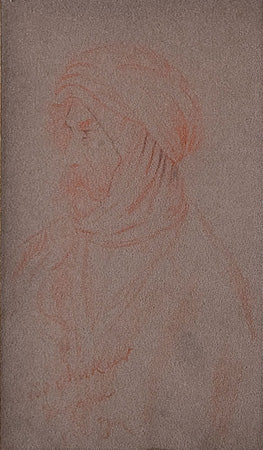
OSMAN HAMDI PORTRAIT
Lot 177
CATALOGUE NOTES
Unsigned. Dated April 7, 1869. Indian djamlik written in lower right corner. Coloured pencil on paper.
Size: 15 x 8.5 cm.
Price: 10,000 TL / $675,676.00
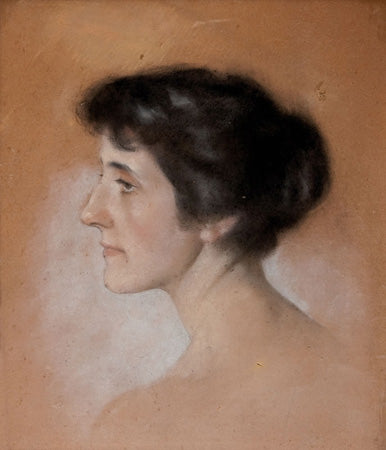
ANONYMOUS WOMAN PORTRAIT
Lot 178
CATALOGUE NOTES
Pastel on paper. 19th century.
Size: 48 x 40 cm.
Price: 4,500 TL / $304,054.00
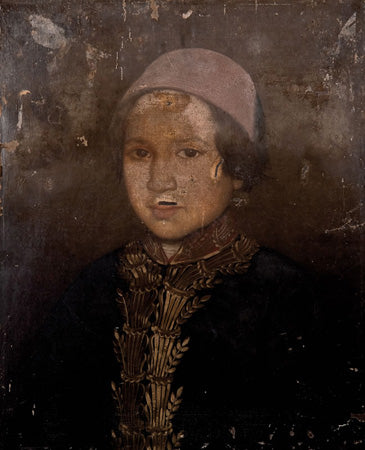
ANONYMOUS OSMAN HAMDI BEY PORTRAIT
Lot 179
CATALOGUE NOTES
Portrait of Osman Hamdi Bey at the age of 11, painted by a French painter. 1853. Oil on canvas. Damaged.
Size: 54 x 44 cm.
Price: 8,000 TL / $540,541.00
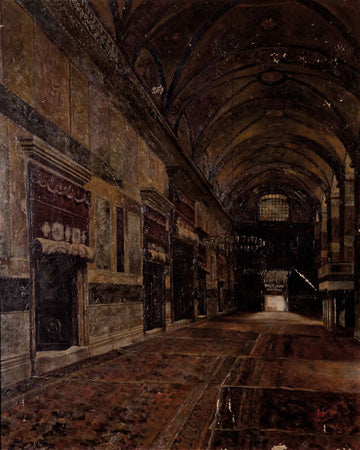
ŞEVKET DAĞ HAGIA SOPHIA LAST CONGREGATION PLACE
Lot 180
CATALOGUE NOTES
Signed in Old Turkish, dated h.1317 (1899). Signed in palette form. Oil on canvas. Duralite polished.
Size: 72 x 60 cm.
Price: 275,000 TL / $185,811.00
– It is on page 39 of the book “Osman Hamdi and the School of Fine Arts” prepared by Adnan Coker and published by Mimar Sinan University in 1983.
Şevket Da., who graduated from the School of Fine Arts in 1897, gave painting lessons at the Mekteb-i Sultani between 1908-1925 and participated in the establishment of the Ottoman Painters' Society. The artist, whose works were exhibited in the Istanbul Salons in 1902 and 1903, presented the interior and exterior spaces, atmosphere and monumentality of structures such as mosques, bazaars and inns to a deep perspective. Şevket Dag's paintings generally do not include figures, and in his few figurative works, the artist uses small-sized figures to emphasize the monumentality of the space.
In this painting of the Hagia Sophia Last Congregation Area, a deep perspective draws the viewer's gaze into the painting, while the warm tones reflected from the carpets spread on the floor and the soft and diffused light reflect the unique otherworldly atmosphere of the space. In this painting, the light of the outside, seen at the end of the last congregation area, is more intense than the interior and is another element that increases depth. In Şevket Dağ's paintings, in addition to perspective, the density of paint and the use of light are the basic features that give the work its expression.
Osman Hamdi Bey admired the paintings of Şevket Dağ, who sincerely depicted the architectural works and decorations of Istanbul in a painterly style and reflected the atmosphere of the buildings, and bought one of his paintings for a very high price at the time. It is possible that this painting was the one Osman Hamdi Bey bought, since it was in the family collection.
Prof. Dr. Semra Germaner
ŞEVKET DAĞ
He graduated from Sanayi-i Nefise in 1897. While he was teaching art at Galatasaray Sultani for a while, he won the appreciation of Tevfik Fikret, the school's principal. Şevket Dağ was effective in giving his students the habit of drawing from nature.
After Galatasaray, he continued this duty at the Istanbul Teachers' Training School. He established a drawing studio at the school. He was meticulous and measured in his private life, as he was in his art. His opening an exhibition in a pudding shop near the Kuyucu Murat Pasha Tomb and showing his paintings to the public during Ramadan, his tireless paintings in mosques for years, and his resistance to bigots who opposed him are all expressions of his love and respect for art.
He is known as an interior painter in our art of painting, especially with his paintings of Hagia Sophia and Topkapi Palace. He approached Hagia Sophia from the perspective of its architectural integrity rather than a historical structure and transferred the structure from different aspects to his paintings. The reflections of light within the structure and the contrast it creates with dim or shadowy sections are seen as concrete data of a sense of space in Şevket Dağ's paintings of this kind. The dim and silent atmosphere of mosque interiors takes on a mysterious visuality in Şevket Dağ's paintings. He pioneered as a special theme painter, outside of the classical genre classification of painting. He developed a working method that is prone to grasping the hidden meanings behind abstract forms and evaluating the potential of art regarding the expression technique. Although he was among the Turkish impressionists, his view of painting showed significant differences in terms of his development and development stages. He was not influenced by the classical and contemporary movements of the West. The artist, who attracted attention with his landscapes and still lifes as well as his interiors, used vibrant colors in a harmonious way in these types of paintings.
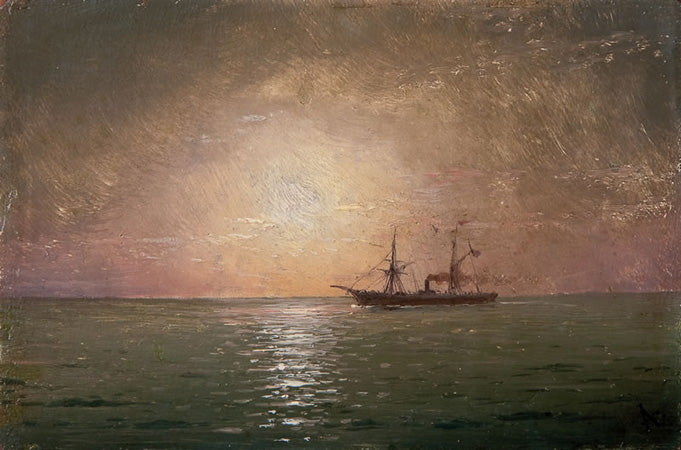
IVAN KONSTANTINOWICH AIVAZOVSKI SEA AND SHIP IN THE MOONLIT NIGHT
Lot 181
Monogrammed. Oil on wood.
Size: 10 x 16cm.
Price: 110,000 TL / $743,243.00
CATALOGUE NOTES
Aivazovsky, who was the most important marine painter of his time together with William Turner, was also very famous in our country as the “Ottoman Palace Painter”. This small masterpiece in Osman Hamdi Bey’s collection tells us a huge story with its vast sea, loneliness and classic steamboat. In this painting, Aivazovsky emphasizes depth and time with the light plays on the waves. As in many of his paintings, he leaves the sunrise and sunset to the interpretation of the viewer. The fact that the painting with the initial “A” is in Osman Hamdi Bey’s collection also gives it a special feature.
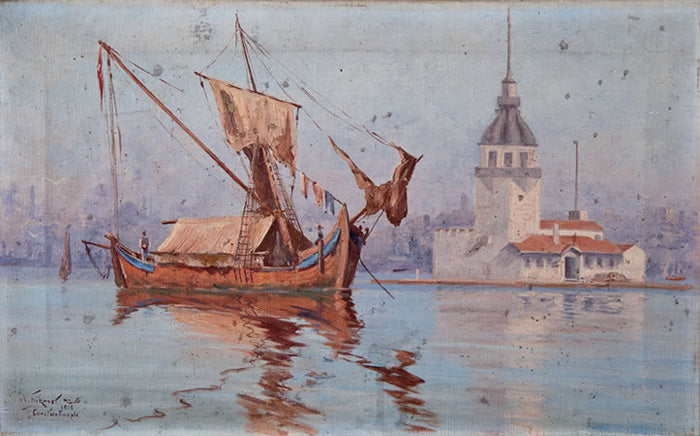
DR. HIKMET HAMDI MAIDEN TOWER
Lot 182
Signed in Old Turkish and Latin letters, dated 1916. "Constantinople" is written below the signature. Oil on canvas.
Size: 29 x 45 cm.
Price: 8,000 TL / $540,541.00
CATALOGUE NOTES
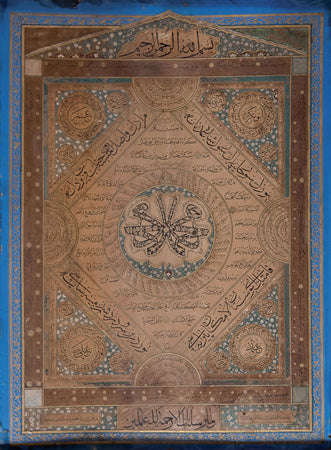
HAFIZ MEHMED SURURI HİLYE-I SHERİF
Lot 183
CATALOGUE NOTES
Ketebeli, dated 1224 h (1809). In celi sülüs müsenna calligraphy, the Basmala, the names of the 4 Caliphs, the Ayet-el Kürsi, the revelation of the Prophet Muhammad, various verses and the names of people who were given the good news of Paradise are written. Illuminated with gold in the classical style.
Size: 73 x 53 cm.
Price: 22,500 TL / $152,027.00
There is generally agreement that the Hilye-i Şerife was invented by Hafız Osman (1052 - 1110 / 1642 - 1698). However, calligraphers over the centuries have experimented with different forms and have written the hilye text and other texts in all kinds of writing on cypress-shaped sheets, inside diagonal centers, around tughras and Ism-i Nebi's. All kinds of formal variations are seen in this hilye written by Seyyid Hafız Mehmed Süruri, who states that he was a student of Seyyid Mehmed Nuri, in 1809. The müsenna double Ism-i Nebi in the middle is decorated in the gülzâr style, which is especially seen in Iran; In addition to Cahar Yar-i Güzin in the four corners, the names of the companions such as Talha, Zubeyr, Abdurrahman, and members of the Ahl al-Bayt such as Fatima al-Zahra, Hasan and Husayn are written inside the round cartridges, and beautiful Turkish verses are added in the form of arches:
“Your face is like the pure robe of the Messenger of the Most Just Shah / If your wish is to reach the presence of the Most Merciful / O my lord, the garden of the world / Your majesty is a yard of light that does not fall to the ground thanks to it” is a rare and carefully written and charming example of Ottoman dervish lodge art.
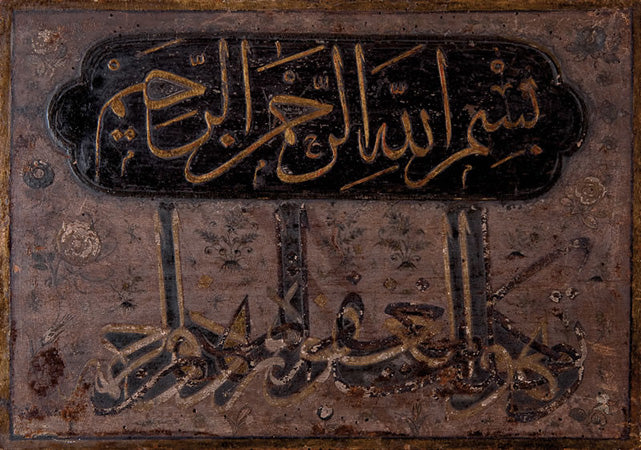
EDIRNEKÂRİ WOODEN ZERENDUD PANEL
Lot 184
Without a ketebe. On a dark brown and black background, the Basmala and “Allah is Forgiving, Merciful” are written in celi sülüs calligraphy. The writing and ketebe at the bottom of the plate are faded. 19th century.
Size: 30 x 41cm.
Price: 10,000 TL / $675,676.00
CATALOGUE NOTES
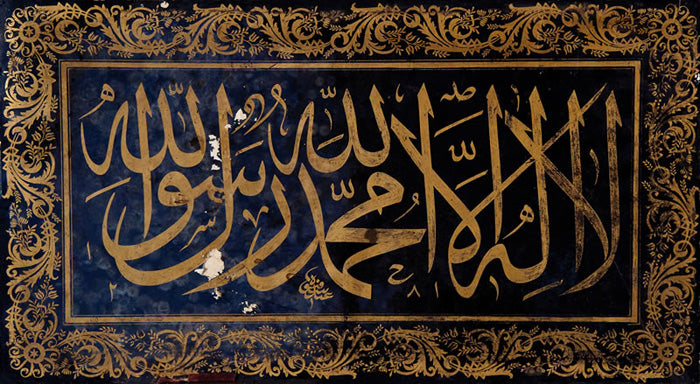
MEHMED SEFIK ZERENDUD PANEL
Lot 185
Ketebeli, dated h.1281 (1864). The Kalima-i Tawhid is written in celi sülüs calligraphy on a black background. It is draped.
Size: 29 x 54 cm.
Price: 5,000 TL / $337,838.00
CATALOGUE NOTES
MEHMED SEFIK
He learned the script from Ali Vasş Efendi. He worked as a teacher for a while. He was sent to Chios by Sultan Abdülmecid. He restored the damaged scripts of Bursa Ulu Mosque and added new scripts. He rose to the highest ranks in thuluth, nesih, celi divani scripts and merit.
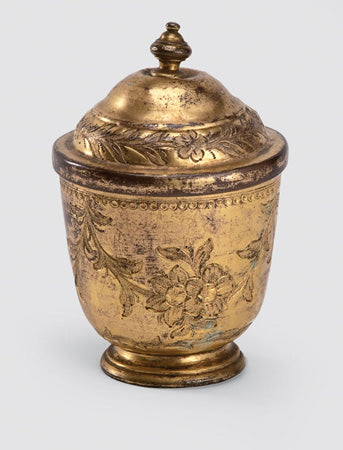
TOMBAK GUM BOX
Lot 186
CATALOGUE NOTES
The bulbous body on a low base has a domed lid. The lid handle is in the form of a bud. It is decorated with large branch, leaf and flower motifs in engraving technique. The tombag is in good condition. 19th century.
Size: Height: 11 cm.
Price: 10,000 TL / $675,676.00
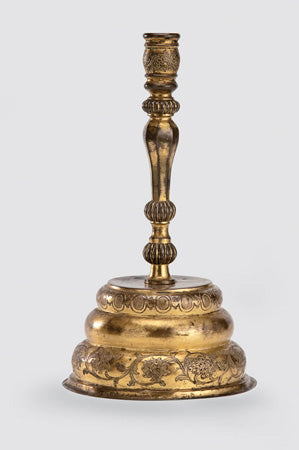
TOMBAC CANDLE HOLDER
Lot 187
CATALOGUE NOTES
The domed candle holder of the long and knotted brass body on a round base is cylindrical in form. Its body is segmented. Its base and candle holder are decorated with grape clusters, vine leaves and large flower motifs in engraving technique. Its tombag is in good condition. 19th century.
Size: Height: 42.5 cm.
Price: 30,000 TL / $202,703.00

FRENCH TORTOSE CLOCK
Lot 188
CATALOGUE NOTES
19th century.
Size: 46 x 23.5 x 15 cm.
Price: 40,000 TL / $27,027.00
Specially made for the Ottomans. The dial has old Turkish numerals. It chimes at half and hourly intervals. The upper part of the high body on four legs is a dome, and the top is in the form of a pine cone. Its foot, contours, side surface and body are decorated with various gilded bronze motifs.
There is a medallion made up of branches on the upper part of the dial. There is a crescent and a star inside the medallion. The side surface and body are decorated with garlands made up of leaves and flowers. The pendulum is missing. The glass cover on the back was added later.
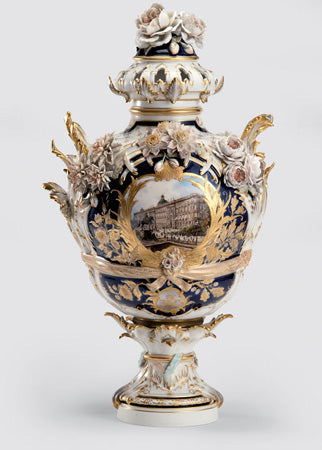
BERLIN PORCELAIN VASE
Lot 189
CATALOGUE NOTES
19th century.
Price: 40,000 TL / $27,027.00
Specially made for the royal family. Stamped "Berlin". The bulbous and wide body on a round base has a narrow mouth. The lid is domed. On both sides of the body, there are two medallions consisting of gold gilded wreaths on a white and cobalt blue background.
Inside the medallions are depicted “Portrait of Guillaume II (1888 - 1918)” and “Le Chateau de Ville de Berlin”. The top and base are decorated with leaves and flowers in relief. The middle is surrounded by a gilded embossed ribbon. The lid handle is in the form of a rose and a rosebud.
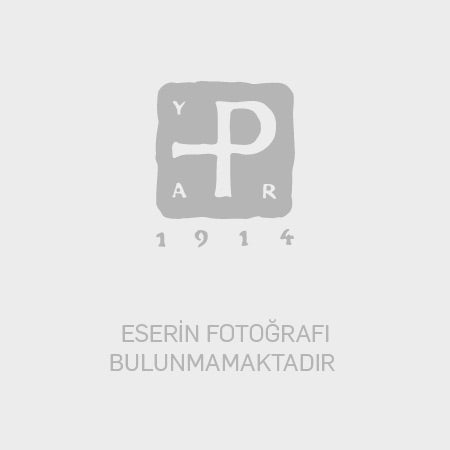
FOUR BOOKS
Lot 190
Price: 3,500 TL / $236,486.00
CATALOGUE NOTES
a) E. Dinet & Sliman Ben İbrahim “The Life Of Mohammed the Prophet of Allah” Paris.
b) Claude Farrere “Cent Dessins de Pierre Loti” Paris.
c) Thomas Allom “Constantinople, The Seven Churches of Asia Minor” Paris.
d) The Works of William Shakespeare, London.

IRAN SILVER SNACKS
Lot 191
Size: Weight: 592 g. 28 x 28 cm.
Price: 2,500 TL / $168,919.00
CATALOGUE NOTES
The three-chambered body is in the form of a plane tree leaf. The border is segmented. The middle is openwork. The handle is in the form of a branch. The openwork border of the wide body with a flat base is segmented. Large leaf and flower motifs are embroidered with the repousseÅL technique. 19th - 20th century. 900 carat.

IRAN SILVER TRAY
Lot 192
Size: Weight: 474 g. 30 x 33 cm.
Price: 1,500 TL / $101,351.00
CATALOGUE NOTES
The wide body with a flat base has a sectioned openwork border. It is decorated with a stylized, curved branch motif using the repousse technique. The border is surrounded by water consisting of stylized flowers. 19th - 20th century. 900 carat.

PROCESSING DRESSING WIPES
Lot 193
Size: 81 x 81 cm.
Price: 700 TL / $472,973.00
CATALOGUE NOTES
Cream colour. The segmented border is surrounded by stylised flowers and old Turkish prayers embroidered with silver glitter. 19th century.
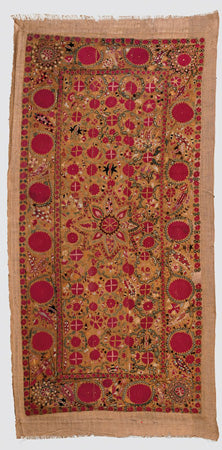
SUZENI COVER
Lot 194
CATALOGUE NOTES
A cream-coloured background with a star in the centre, surrounded by a dark red stylised rosette flower and green curled leaf motif. 19th century.
Size: 217 x 104 cm.
Price: 4,000 TL / $27,027.00
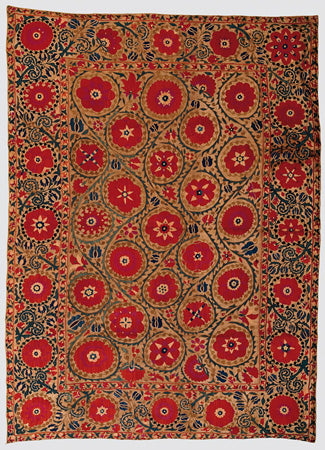
SUZENI COVER
Lot 195
CATALOGUE NOTES
Adorned with a dark red stylized rosette flower and a blue curved branch motif on a cream-colored background. Late 19th century.
Size: 226 x 165 cm.
Price: 7,000 TL / $472,973.00
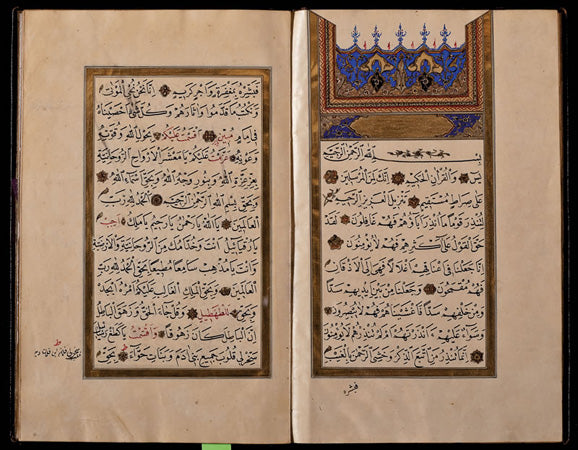
AZIZ RUFAI YASIN PARTICULAR
Lot 197
Ketebeli, dated 1320 (1902). Written in Naskh script. Illumination was made by the calligrapher himself. Title page is illuminated in gold. Each page has 13 lines. Number of pages: 31.
Size: 23.5 x 15 x 0.5 cm.
Price: 10,000 TL / $675,676.00
CATALOGUE NOTES
It was a common practice among Ottoman calligraphers to write the Yasin sura of the Holy Quran as a separate booklet. This Yasin sura, whose illumination is as elegant as its writing, was written by one of the most popular calligraphers of the recent period.
It is the work of Sheikh Abdulaziz Rifai (1289 - 1353 / 1871 - 1934). He must have liked what he wrote because he wrote it in the script of Riqaa (Ijazah) with his teacher Filibeli
He deemed it appropriate to mention the name of Ahmed Arif Efendi (Grocer Arif). The notes in the footnotes are in Turkish.
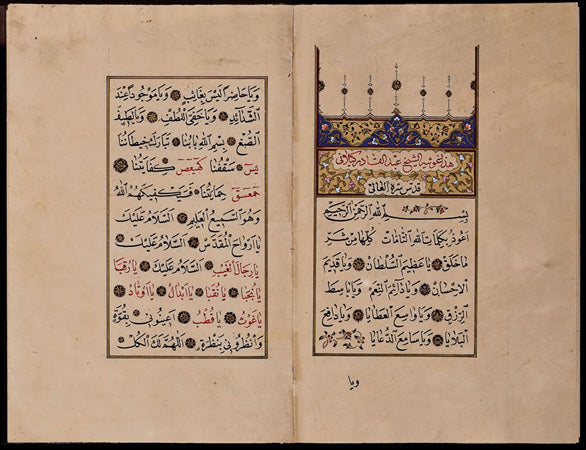
AZIZ RUFAIKADIR EVRADI
Lot 198
(GAVSİYE-İ ŞERİFE LICENSE) Without a cassette, dated 1322 h (1904). Written in Naskh script. About the permission given to recite the Gavsiye-i Şerife Prayer for the spirit of Abdülkadir Geylani in the Qadiri Order. The title page is illuminated with gold. The binding, which is in the style of Zilbahar, was renewed in a later period. Each page is 11...
Size: 18 x 12 x 0.5cm.
Price: 3,000 TL / $202,703.00
CATALOGUE NOTES
This manuscript, which contains the work of Sheikh Abdulkadir Geylani called Gavsiyye, is actually a recitation permit. The entry at the end reads as follows: “Permission was granted to Esseyyid Abdüşşükûr Efendi to recite this Gavsiyye-i Şerife. Year 1322 (1904). Hâdim-i Hankah-ı Kadirîhâne Şerif Mehemmed el-Kadirî.” The writing is very beautiful. Its illumination and binding were made later.
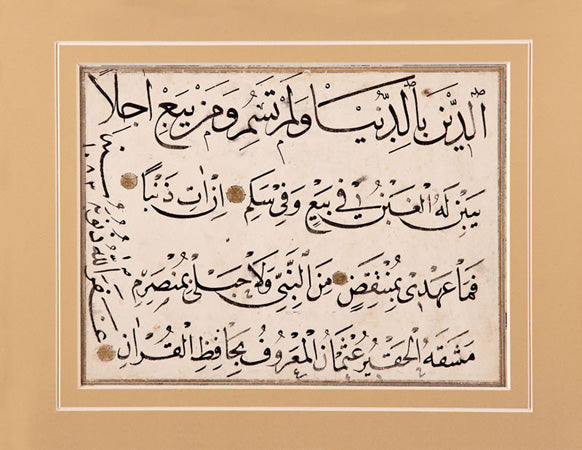
HAFIZ OSMAN KIT
Lot 199
Ketebeli, dated 1083 (1672). Hadith-i Sharifs written in thuluth and nesih (thuluth pen) calligraphy. Gold beyne's-sutur.
Size: 24 x 28cm.
Price: 900 TL / $608,108.00
CATALOGUE NOTES
HAFIZ OSMAN
Hafız Osman is the second genius of Turkish calligraphy after Şeyh Hamdullah. He was born in Istanbul. He memorized the Quran at a young age and was raised under the protection of Köprülüzade Fazıl Mustafa Pasha.
He started taking lessons from Derviş Ali because of his interest in calligraphy. However, due to his old age, his teacher wanted this talented student to be trained by Suyolcuzade Eyyubi Mustafa Efendi. Hafız Osman received permission from his first teacher for the writing styles of reyhani, tevki and rik'a.
After this authorization, he began to learn all the features of Sheikh Hamdullah calligraphy and studied his works. The calligrapher, who began to seek innovations in calligraphy after the age of 40, began to produce works in his own style by adding his own creativity and taste to the Sheikh's writings, starting in 1679. Among the works he produced with Aklam-ı Sitte are Qur'ans, En'am-ı Şerişer, Delail-i Hayrat, stanzas, scribbles and murakkas. Another invention that Hafız Osman brought to the art of calligraphy was the Hilye-i Şerif in the form of a plate, which had never been seen before.
Hafız Osman, who also taught calligraphy to Sultan Ahmed III during his princedom and to Sultan Mustafa II during his reign, left behind a new school of calligraphy, students who sought to attain his art, and works that are masterpieces in museums.
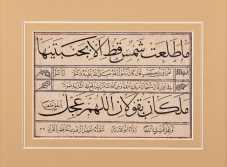
ISMAIL ZÜHDI KIT
Lot 200
Ketebeli. Hadith Sharifs are written in thuluth and naskh calligraphy.
Size: 20 x 25cm.
Price: 5,000 TL / $337,838.00
CATALOGUE NOTES
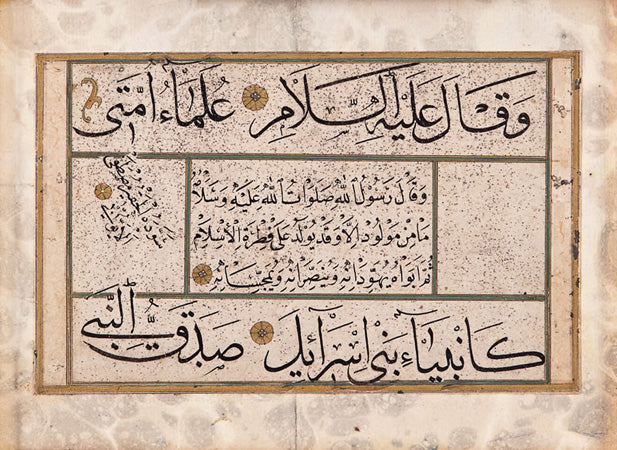
“SUYOLCUZADE” MUSTAFA EYYUBİ KIT’A
Lot 201
Ketebeli. Hadith-i Sharifs are written in thuluth and naskh calligraphy. With golden beyne's-sutur.
Size: 20 x 26 cm.
Price: 6,000 TL / $405,405.00
CATALOGUE NOTES
Suyolcuzade Mustafa Ayyubi (d. 1097 / 1686), who was the teacher of Hafiz Osman, left behind many works, but very few of his works have survived to the present day. There are two famous hadiths on this thuluth-naskh tablet. “The scholars of my community are like the prophets of the Children of Israel” in thuluth script and “Everyone who is born is born in accordance with the nature of Islam, then his parents make him a Jew, Christian or Zoroastrian” in neskh script. It is an important work both in terms of its text and its writing.
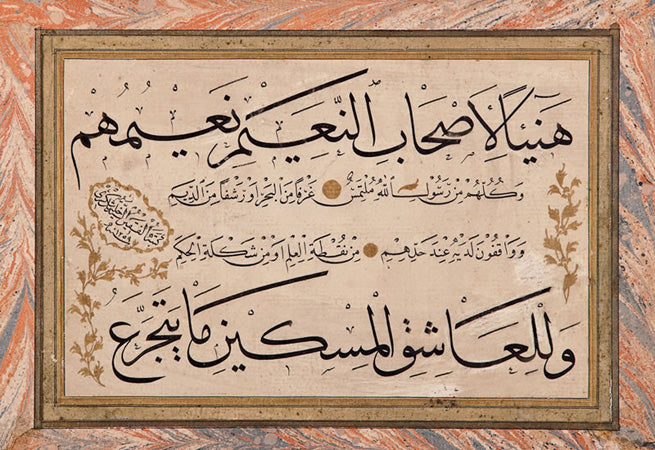
ESSEYYID HALİL ŞÜKRÜ MEŞK KIT'A
Lot 202
Ketebeli, dated 1259 (1843). Written in Thuluth and Naskh script. Illuminated in gold in the classical style. Border marbling by Necmeddin Okyay.
Size: 23 x 29 cm.
Price: 5,000 TL / $337,838.00
CATALOGUE NOTES
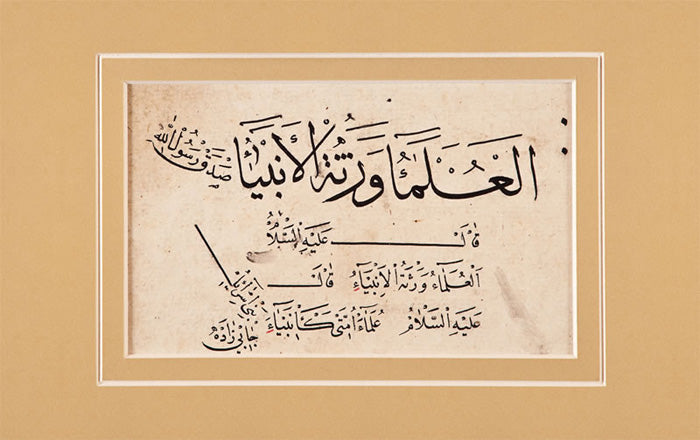
“CABIZADE” TO ABDULLAH KIT
Lot 203
Ketebeli. Hadith Sharifs are written in thuluth and naskh calligraphy.
Size: 19 x 25 cm.
Price: 4,000 TL / $27,027.00
CATALOGUE NOTES
Câbizâde Abdullah Ağa (d. 1149 / 1736) was a student of Suyolcuzâde Mustafa Ayyûbî. In this thuluth-nesih stanza, as in the above stanza of his teacher, there are two hadiths in which scholars are mentioned. “Scholars are the heirs of the prophets” in both thuluth and nesih script, and “The scholars of my ummah are like the prophets of the Children of Israel” in only nesih script.
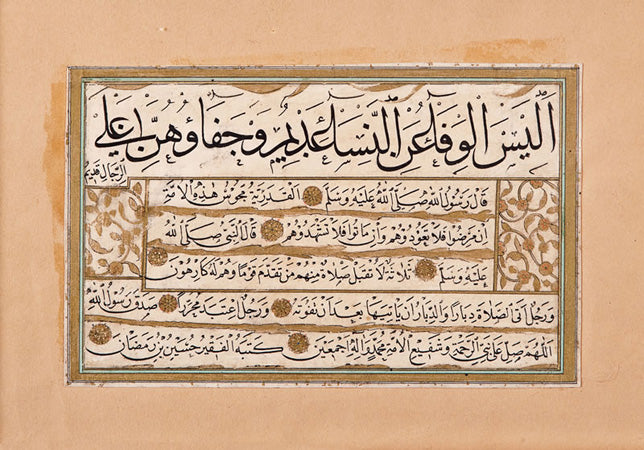
HUSEYIN “HABLI” BIN RAMADAN KIT’A
Lot 204
With a ketebe. Hadith-i Şerifs written in thuluth and naskh calligraphy. Gold beyne's-sutur. The seats are illuminated with gold in the classical style.
Size: 19 x 28cm.
Price: 5,000 TL / $337,838.00
CATALOGUE NOTES
Hüseyin bin Ramazan (d. 1157 / 1744), after coming to Istanbul, earned his living as a habbal, or rope maker, in Zindankapısı, so he is known as Habli or Rope Maker Hüseyin. He was a student of the Second Dervish Ali. This sülüs-nesih stanza containing hadiths is decorated with gold in the beynessutur style.

ESSAYID HAFIZ IBRAHIM HAKKI-EL KONEVI QURAN
Lot 205
Size: 19 x 12.5 x 2 cm.
Price: 10,000 TL / $675,676.00
CATALOGUE NOTES
Ketebeli, dated 1282 (1865). Written in Nesih script. Verse berkenar (Completion of each verse on the page where it starts) Written in Nesih script. Its header is illuminated with gold. Its illumination was made by Mustafa Efendi. The leather binding decorated with geometric patterns was renewed in a later period. Each...
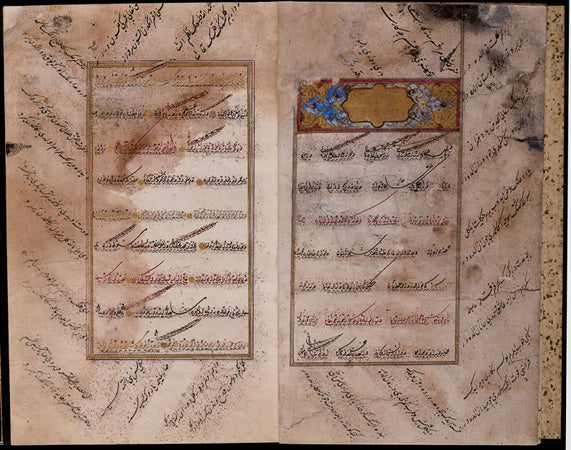
BUILDING BOOK
Lot 206
Size: 21 x 14 x 1.5 cm.
Price: 2,000 TL / $135,135.00
CATALOGUE NOTES
It is a unique example of a book about the Ottoman bureaucracy.
MUur Cure.
(Ornamented Ottoman Prose) Period of Suleiman the Magnificent (1520 - 1566). Without a cassette. Written in the Hurde Talik, Siyakat, Divanî and Celi Divanî scripts using gold, garnet, blue and soot ink. Title page is illuminated with gold. Leather binding decorated with a Shams motif was renewed in a later period. Number of pages: 172....
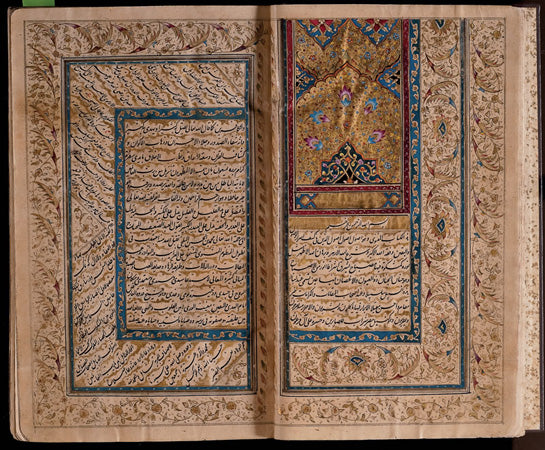
MESNEVI-I MEVLEVI
Lot 208
Size: 20.5 x 13 x 4 cm.
Price: 20,000 TL / $135,135.00
CATALOGUE NOTES
Iran. Qajar period. Without ketabe, dated 1229 (1813). Consisting of 6 books in a single volume. Written in Persian Hurde Talik script. The title page at the beginning of each book is finely illuminated with gold in the style of the period. The leather binding in the Zilbahar style was renewed in a later period. Number of pages: 930.

RISE OF SHEVKNAME
Lot 209
Size: 17.5 x 13 x 1.5 cm.
Price: 9,000 TL / $608,108.00
CATALOGUE NOTES
Without a kite. Dedication to Sultan Bayezid II (1481 - 1512). Written in Persian Hurde Talik script. Concerning methods of bringing people to enthusiasm. Title page is illuminated with gold. The leather binding of the period is decorated with şems motifs. Inside the cover is an old Turkish information note by Prof. Dr. A. Süheyl Ünver about the book...
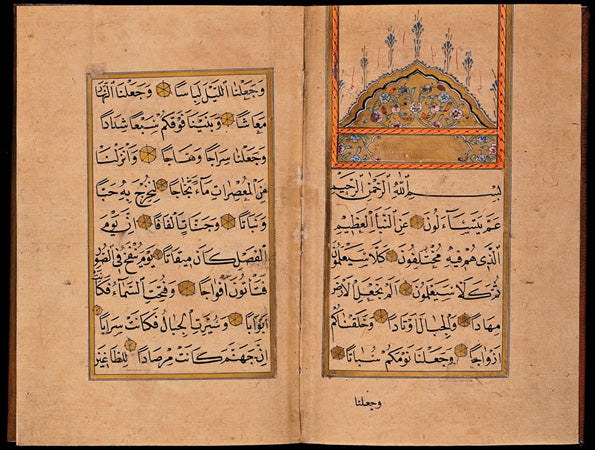
ALI HAFIZUL QURAN SURAH AN-NEBA (IJAZET)
Lot 210
Size: 19 x 12.5 x 0.5cm.
Price: 3,000 TL / $202,703.00
CATALOGUE NOTES
Ketebeli, dated 1164 (1750). Permission granted by Ketanizade Ali (? - 1778). Written in Naskh script. Title page is illuminated with gold. Marbling inside the cover was done by Hagia Sophia preacher Mehmed Efendi. Leather binding decorated with Zilbahar motif was renewed in a later period. Number of pages: 6.

DERVISH MEHMED MORAL HADICATUS SUEDA
Lot 211
Size: 25 x 17 x 3cm.
Price: 20,000 TL / $135,135.00
CATALOGUE NOTES
(GARDEN OF THE HAPPY) Ketebeli. Written in Istanbul in the talik script, one of Fuzuli's most important works. The gold tughra of Suleiman the Magnificent on the last page was made in a later period. Its title is illuminated in gold in the classical style. The leather binding decorated with floral motifs was made later.
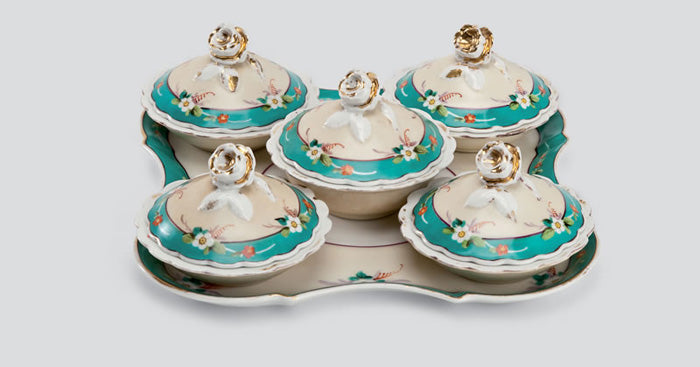
PORCELAIN IFTAR SET
Lot 212
Europe. Specially made for the Islamic market. Consists of a tray and 5 iftar bowls. The tray has a flat bottom and a wide body. Iftar bowls have a flat bottom, a flat body and a domed lid. The lid handle is in the form of a rose. The tray and lid border are surrounded by green water. Various colored flower motifs on a cream colored background...
Price: 2,250 TL / $152,027.00
CATALOGUE NOTES
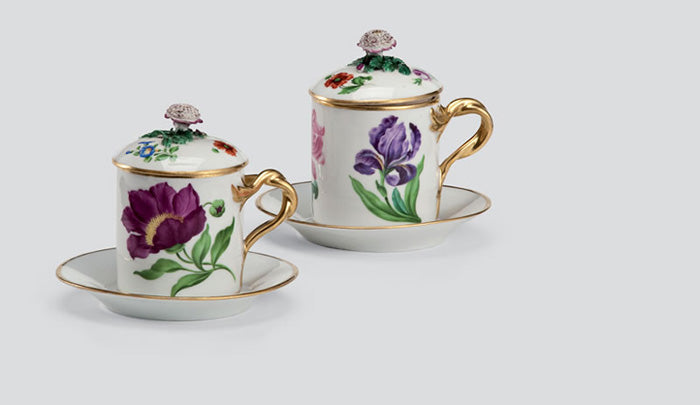
VIENNA PORCELAIN 2 SAHLEP DISHES AND PLATE
Lot 213
Specially made for the Ottomans. Sahlep bowl with a flat bottom, bulbous body and domed lid. Lid handle is in the form of a flower, gilded ivy handle. Plate with a flat bottom and low rim. Decorated with large flower motifs in various colors on a white background. 19th century.
Size: Height: 13 cm.
Price: 3,500 TL / $236,486.00
Diameter: 15 cm.
